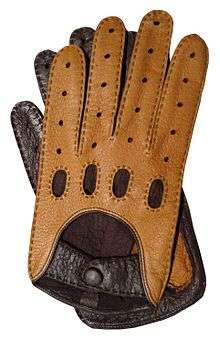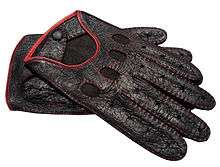Driving glove

A driving glove is a hand covering, typically constructed of very thin, soft leather, used to give a driver increased control of the vehicle through enhanced grip of the steering wheel and gear stick. The grain present on the leather and the pores present in the leather give the gloves the unique ability to assist the wearer as he or she grips the steering wheel and gear stick. As soft as a leather glove may be, its pores and grain provide a level of friction when "gripped" against an item or surface.[1]
The gloves usually have separate sheaths or openings for each finger and the thumb. They are designed for holding a steering wheel. These gloves also provide a good feel and add comfort to the hands. They fit tight and do not interfere with the hands' movements. The increased grip allows for more control, and increased safety at high speeds.[2]
History
Driving gloves were originally worn to keep the hands clean when driving a motor car and looked like gauntlets. Early racing cars used steering wheels taken directly from road cars. These wheels were normally made from wood, necessitating the use and development of driving gloves.[3]History of racing driving gloves from well known automotive eras was hand in hand with its design beginning from Silver Arrows through Grand Prix and nowadays & modern gloves.
Current use
Driver’s gloves fulfill at least two functions: grip and protection. Although maximum tactility is an obvious starting point for driving gloves, any glove can be marketed as a driver’s glove, and can improve the grip on the steering wheel. Some owners of classic cars still wear driving gloves in order to protect the vintage wooden or ivory steering wheel.
Design
True driving gloves can be identified by the fact that they offer tactile advantages to drivers handling a car near the limits of adhesion. Made of soft leather, drivers gloves are unlined with external seams, which makes them seamless inside so as not to interfere with the sensitivity of the drivers touch on the steering wheel, and subsequently information from where the tire contacts the road.
Driving gloves feature open knuckles and back for maximum flexibility; ventilation to reduce stress on the soft, thin leather; holes punched in fingers and palms for ventilation; short cuffs so as not to restrict movement; and a stud fastener closure on the back for proper fit around the wrist and unobstructed view of the drivers chronograph.
Racing driver's gloves

Racing gloves are specifically designed not only for increased grip and performance, but also for protection against heat and flame for drivers in automobile competitions.[4] Racing gloves must have cuffs to provide thermal shielding in conjunction with racing driver’s suits. They are made of Nomex.
Because leather shrinks considerably when exposed to flame, the glove's leather is usually limited only to the tactile areas of the hand. There is usually no leather on the cuff, on the back of the hand, or between the fingers (also called fourchettes). The racing glove is supposed to be tight either at the wrist or at the extremity of the cuff.[5]
The leather is meant to be used as an additional layer of material. The seams for attaching the leather have to be separate from the structural seams of the glove. The thickness of the leather is preferably as thin as possible.[6]
Drivers of single-seater cars in races with standing starts must wear gloves in a high-visibility color, which contrasts with the predominant color of the car, so that the driver can clearly draw the attention of the race starter in case of difficulties.[7]
Styles
- Unlined - The unlined designs allow the fingers senses through, so that drivers do not lose a layer of sensitivity lost with lined gloves.
- Lined - Driver’s gloves are frequently used to keep the hands warm, a function that is particularly necessary during top down operation in cold weather. The design of cars is such that the driver's hands remain on the steering wheel while driving, a position that leaves them exposed to the elements. The hands are also relatively inactive, and do not have a great deal of muscle mass, which also contributes to the possibility of chill. Lined gloves therefore contribute to insulating the hands while driving.
- Full fingered - Gloves should fit snugly but not be tight. Pay particular attention to the length of the fingers as the fingertips can become very cold if the glove's fingers are not long enough. Ideally the glove should be loose on the fingers and fit comfortably around the palm. A tight glove will tend to restrict blood flow and make the hand cold as it is at an extreme distance from the heart.
- Fingerless - Fingerless gloves have the fingers cut off. The exposed fingers interfere less with the sensation of gripping.
See also
- Baseball glove
- Batting glove
- Boxing glove
- Cycling glove
- Goalkeeper glove
- Golf gloves
- Lacrosse glove
- MMA gloves
- Wicket-keeper's gloves
References
- ↑ "Frequently Asked Questions". Retrieved 2 October 2014.
- ↑ "What are driving gloves". Retrieved 2011-02-01.
- ↑ "The Official Formula 1 website". Retrieved 2011-02-01.
- ↑ "FIA Standard 8856-200 Protective clothing for automobile drivers" (PDF). p. 2. Retrieved 2011-02-01.
- ↑ "FIA Standard 8856-200 Protective clothing for automobile drivers" (PDF). p. 9. Retrieved 2011-02-01.
- ↑ "FIA Standard 8856-200 Protective clothing for automobile drivers" (PDF). p. 10. Retrieved 2011-02-01.
- ↑ "Appendix L to the International sporting code" (PDF). 6 January 2011. p. 14. Retrieved 2011-02-01.